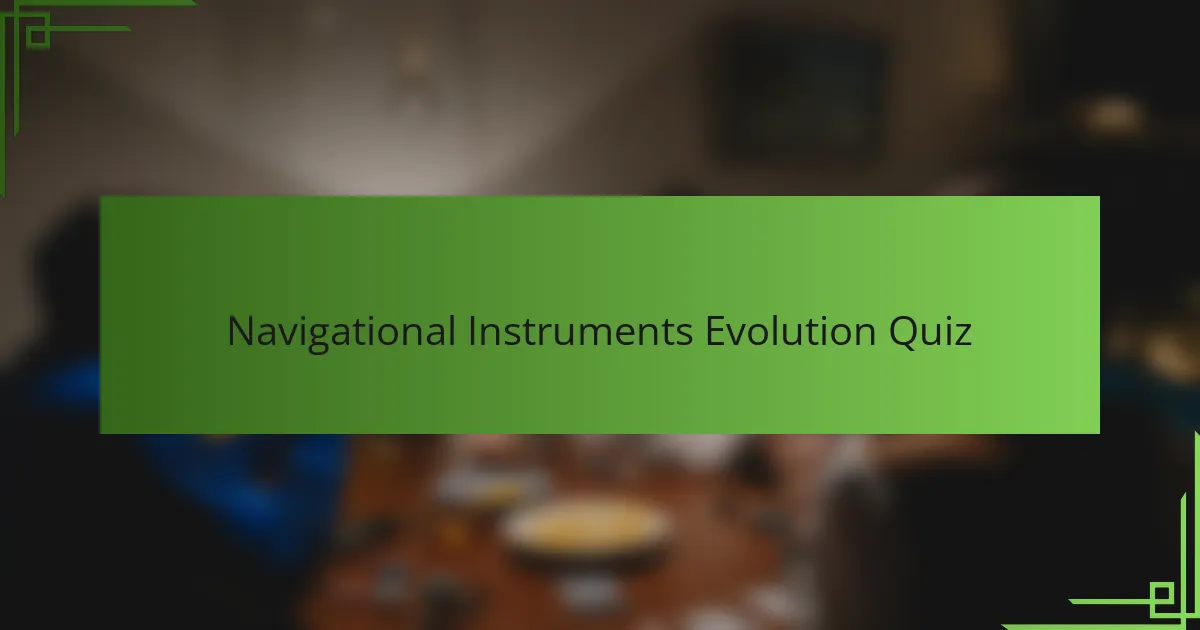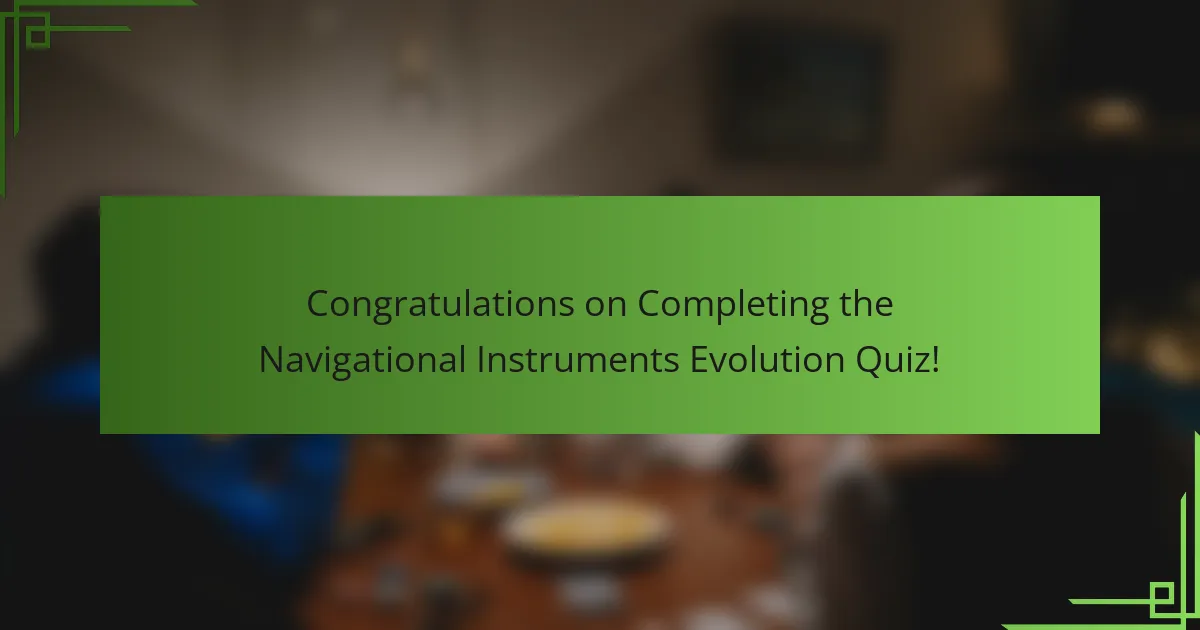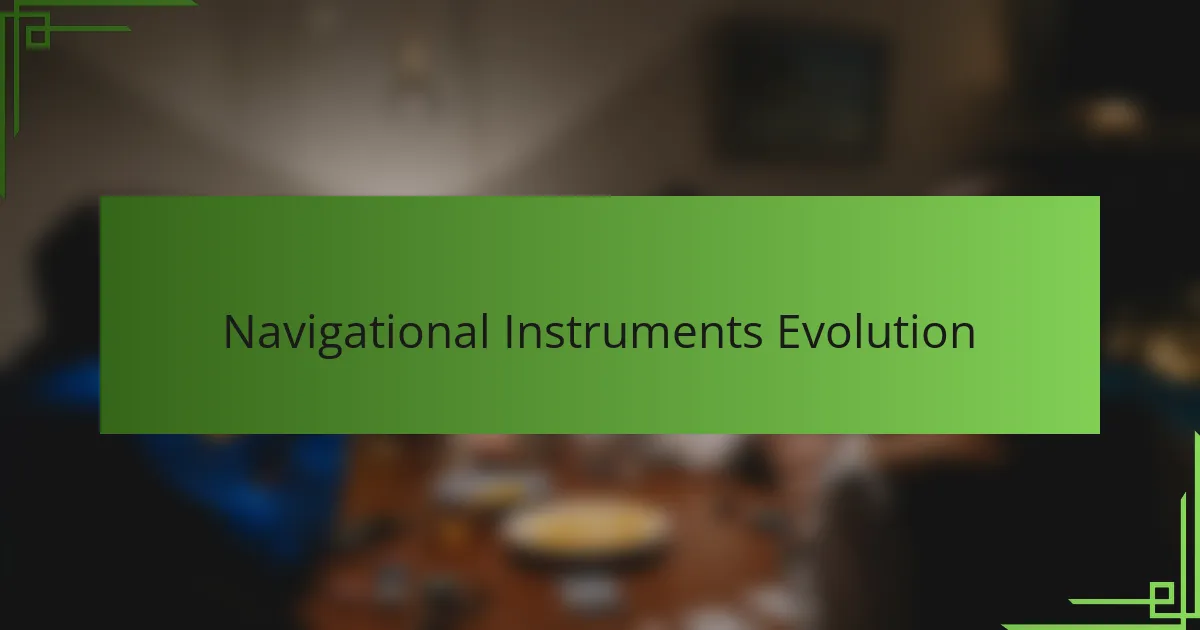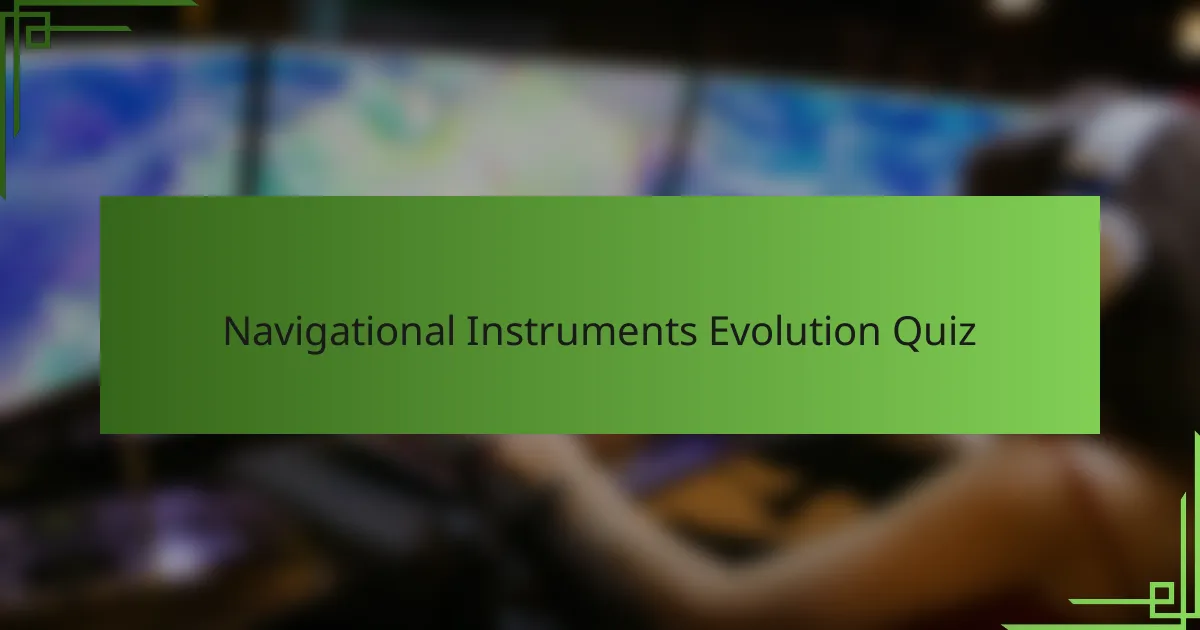
Navigational Instruments Evolution Quiz
1. What is the primary navigational instrument traditionally used by sailors to determine their latitude at sea?
- Compass
- Astrolabe
- Sextant
- Chronometer
2. Who is credited with inventing the marine chronometer, which revolutionized longitude calculation?
- Christiaan Huygens
- Isaac Newton
- Galileo Galilei
- John Harrison
3. Which navigational instrument uses Earth`s magnetic field to indicate direction and was essential in early maritime exploration?
- Chronometer
- Sextant
- Magnetic compass
- Astrolabe
4. What is the name of the ancient Greek instrument used for measuring the altitude of stars, aiding early navigation?
- Quadrant
- Armillary sphere
- Astrolabe
- Sextant
5. Which 18th-century device improved dead reckoning by measuring a ship’s speed through water?
- Sextant
- Chronometer
- Astrolabe
- Log line
6. What innovation by John Harrison significantly improved long-distance sea navigation accuracy?
- Magnetic compass
- Marine chronometer
- Sextant
- Lead line
7. In the evolution of navigation, which instrument replaced the astrolabe for more precise star observations?
- Backstaff
- Sextant
- Cross-staff
- Quadrant
8. Which navigational tool, developed in the 20th century, uses radio signals to determine a ship’s position?
- Transit Satellite Navigation
- LORAN (Long Range Navigation)
- Omega Navigation System
- Decca Navigator System
9. What navigational method relies on observing the position of celestial bodies and was primarily used before modern instruments?
- Dead reckoning
- Satellite navigation
- Celestial navigation
- Radio navigation
10. Which compass variant includes a liquid-filled housing to stabilize the needle and improve accuracy?
- Gyrocompass
- Liquid compass
- Azimuth compass
- Magnetic declination compass
11. What is the name of the early portable navigation instrument that resembles a protractor and was used for plotting courses?
- A plotting protractor
- A compass rose
- A traverse board
- A maritime sextant
12. Who is known for popularizing the use of the cross-staff in maritime navigation during the 16th century?
- Gerardus Mercator
- Abraham Ortelius
- Martin Behaim
- Gemma Frisius
13. What modern navigational instrument uses satellite signals and has largely replaced traditional tools like the sextant?
- Marine Chronometer
- Radio Direction Finder
- Gyroscopic Compass
- Global Positioning System (GPS)
14. Which ancient civilization is credited with early development of navigation techniques using stars and landmarks?
- Phoenician civilization
- Minoan civilization
- Mesopotamian civilization
- Ancient Egyptian civilization
15. What device, often paired with a compass, was used by explorers to measure a ship’s altitude relative to the horizon?
- Astrolabe
- Sextant
- Chronometer
- Quadrant

Congratulations on Completing the Navigational Instruments Evolution Quiz!
You’ve reached the end of our quiz on the evolution of navigational instruments, a journey through geography that highlights humanity’s quest to explore and understand our world. Throughout the quiz, you engaged with key developments that transformed navigation from rudimentary tools to precise devices. This process not only reinforces your knowledge but also deepens your appreciation for the technological advances that have shaped global exploration.
Many learners discover fascinating facts about instruments such as the compass, sextant, and modern GPS, gaining insight into their functions and historical impact. Understanding these tools provides a clearer picture of how geographic discoveries unfolded and how sailors and explorers overcame challenges at sea. This knowledge is essential in appreciating the role geography plays in connecting societies and expanding horizons.
We invite you to explore the next section on this page, where we delve deeper into the topic of navigational instruments and their significance in geography. This additional information will help you expand your understanding and uncover even more details about the remarkable tools that have guided explorers across the globe. Continue your learning adventure and enhance your grasp of geography’s vital features.

Navigational Instruments Evolution
The Origins of Navigational Instruments in Geography
Navigational instruments are tools designed to assist in determining position and course during travel. In geography, their evolution began with early devices like the astrolabe and compass. The magnetic compass, first widely used by Chinese mariners during the Song Dynasty, revolutionized navigation. It allowed geographic explorers to determine direction without relying solely on celestial bodies, enhancing sea travel far beyond coastal areas.
The Impact of the Magnetic Compass on Geographic Exploration
The magnetic compass, developed in the 11th to 12th centuries, became a cornerstone in geographic navigation. Its ability to point toward magnetic north facilitated accurate orientation and route plotting on both land and sea. Mariners such as those from the Age of Discovery, including Portuguese explorer Vasco da Gama, used the compass extensively to navigate uncharted waters, which significantly expanded global geographic knowledge.
The Role of Sextants in Advancing Geographic Precision
The sextant, introduced in the 18th century, enhanced the accuracy of measuring celestial angles between the horizon and a star or sun. It became crucial for determining latitude and longitude with precision. Navigators like Captain James Cook relied on sextants during their voyages to map coastlines and features on the globe accurately, marking a significant leap in geographic data collection.
The Introduction of Chronometers and Longitude Calculation in Geography
Marine chronometers, invented by John Harrison in the 18th century, solved the challenge of determining longitude at sea. By providing an accurate time reference, they enabled navigators to calculate longitudinal positions relative to a known meridian. This breakthrough improved the precision of geographic cartography and allowed explorers to establish reliable global positioning systems during extended maritime expeditions.
The Transition to Modern Navigational Instruments and Geographic Information Systems
Contemporary navigation integrates satellite-based systems like GPS (Global Positioning System) developed by the United States Department of Defense. GPS provides real-time geographic positioning globally, using a constellation of satellites. This advancement has transformed geographic navigation, enabling precise mapping, route planning, and spatial analysis in diverse fields such as geology, environmental science, and urban planning.
What were the earliest navigational instruments used in geography?
The earliest navigational instruments in geography included the astrolabe, compass, and sextant. The astrolabe, developed around 150 BC in the Hellenistic world, was used to measure the altitude of stars to determine latitude. The magnetic compass, invented in China during the Han dynasty around the 2nd century BC, provided directional orientation using Earth’s magnetic field. The sextant, invented in the 18th century, allowed mariners to measure the angle between a celestial object and the horizon for precise latitude measurement. These instruments laid the foundation for geographic navigation.
How did the development of the magnetic compass impact navigation?
The development of the magnetic compass greatly improved navigation by providing a reliable and consistent means of determining direction regardless of weather or visibility. This instrument enabled sailors to steer accurate courses even when landmarks or celestial bodies were not visible. Invented in China during the Han dynasty and introduced to Europe by the 12th century, the compass revolutionized maritime geography by facilitating longer sea voyages and global exploration, as seen during the Age of Discovery in the 15th and 16th centuries.
Where were significant advancements in navigational instruments made?
Significant advancements in navigational instruments were made in several geographic regions: Ancient Greece with the development of the astrolabe; China with the invention of the magnetic compass; and Europe during the Renaissance, especially in countries like Portugal and England, where improvements to the sextant, chronometer, and marine chronometer occurred. These regions were crucial centers for enhancing navigational technology that supported geographic exploration and mapping.
When did the marine chronometer become essential for navigation?
The marine chronometer became essential for navigation in the late 18th century, particularly after John Harrison completed a working model in the 1760s. This instrument solved the problem of determining longitude at sea by providing highly accurate timekeeping despite ship movement. Its widespread adoption by the early 19th century revolutionized geographic navigation and allowed for precise global positioning, critically improving maritime exploration and trade routes.
Who were key figures in the evolution of navigational instruments?
Key figures in the evolution of navigational instruments include Hipparchus, who contributed to the development of the astrolabe; Shen Kuo and the unknown Chinese inventors responsible for the magnetic compass; John Davis, credited with improvements to the backstaff; and John Harrison, whose creation of the marine chronometer in the 18th century was fundamental to solving the longitude problem at sea. These individuals advanced geographic navigation by enhancing measurement accuracy and reliability.
